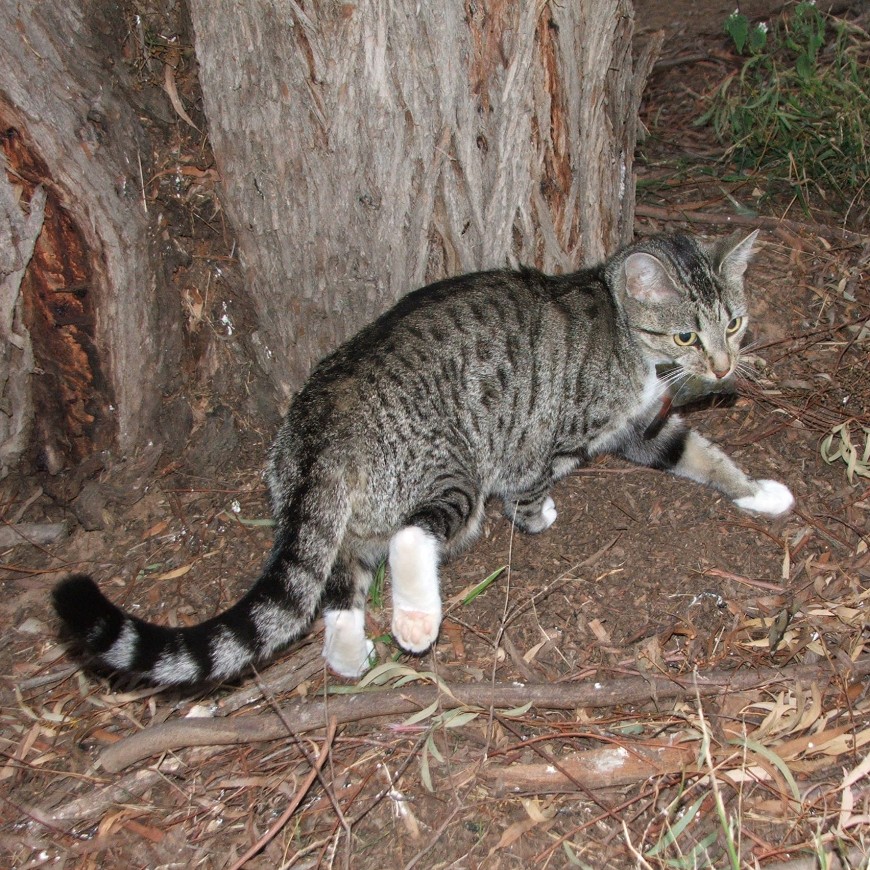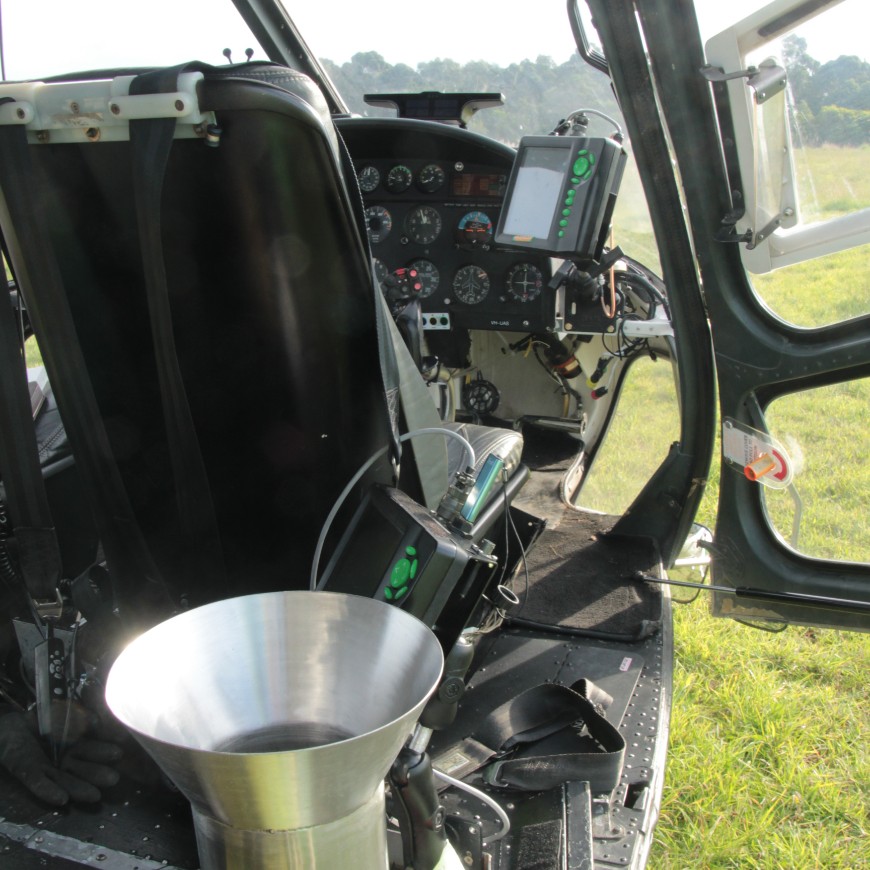Effective feral cat control programs rely on an integrated and coordinated approach using multiple tools, usually across a broad area. In most circumstances, baiting is the most effective, landscape-scale feral cat control tool available. It can also provide 24-hour unmanned control.
At a landscape scale, baiting can achieve significant population reductions across a wide area with relatively minimal effort in a cost-effective way.
Two toxins are approved for use in feral cat control in Australia: 1080 (sodium fluoroacetate) and PAPP (para-aminopropiophenone). Commercially available, ready-to-lay baits are Eradicat® 1080 baits and Curiosity® PAPP baits. Injected fresh meat baits are currently not approved for use on feral cats.
These baits consist of a palatable sausage bait containing a measure of toxin. Both bait products are species selective – they are designed to reduce off-target poisoning of native Australian wildlife.
In Eradicat® 1080 baits, species selectivity is provided by using 1080 (4.5 mg per bait) as many Australian animals have some degree of natural tolerance to the toxin, while feral cats and other invasive pests do not. Currently, Eradicat® can only be used in Western Australia with required approvals, or in other states with a minor-use permit for specified locations for conservation programs.
In Curiosity® PAPP baits (78 mg PAPP), species selectivity is provided by encapsulating the dose of PAPP within hard-shelled plastic pellets embedded in the sausage. Unlike 1080, native wildlife have no natural resistance to PAPP. Many native animals that may be interested in the bait are more likely to nibble on it, than swallow it whole, and they avoid eating solid objects, protecting them from the PAPP pellet. This is not the case for some species like goannas, quolls and birds like ducks.
Feral cats, on the other hand, will readily swallow large chunks of food, including PAPP pellets, which break down in the stomach and release the PAPP dose.
Hisstory® 1080 is a bait product currently under development, which uses the same encapsulated pellet system as the Curiosity® PAPP bait. This further reduces the risk to off-target native species that might be at risk of eating a lethal dose of 1080. Hisstory® 1080 baits are not yet approved for use.
Sodium fluoroacetate is a naturally occurring toxin found in more than 30 species of native Australian plants, including Acacia georginae (Georgina gidgee) and Gastrolobium. Many Australian native animals, particularly in the south-west of Western Australia, have developed a tolerance for 1080 because they co-evolved with these plants and therefore the toxin. The small amount of toxin needed to target feral cats reduces the risk to many off-target native animals.
PAPP and 1080 are safe in the environment, as they dilute into harmless compounds in water and get broken down by the bacteria and microorganisms in soil and water.
The risk of secondary poisoning is also very low, as a susceptible animal would need to eat the bait from the stomach of a poisoned animal or its vomit before the toxin degrades.
The risk to off-target species needs to be assessed and minimised when using either 1080 or PAPP based baits.
Baiting methods for feral cats include ground baiting and aerial baiting. Each approach has advantages and things to consider.

Ground baiting with Curiosity® PAPP baits. Photo: Julie Trezise.

Sausage style Eradicat® 1080 bait. Photo: DBCA
Advantages of baiting
- Baiting is one of the most effective tools available for feral cat control in Australia.
- It is extremely cost effective over a larger area compared to other control tools.
- It delivers landscape scale population reduction of invasive predators.
- Baiting is easily incorporated into general farm- and pest-management activities.
- The toxin type, bait type and baiting method allow this tool to be relatively species specific.

Baiting is one of the most effective tools available to reduce the impacts of feral cats on our native wildlife. Photo: Tony Buckmaster.
Things to consider when baiting
- Baiting is strictly regulated in Australia. Legislation currently prohibits the use of some baits and methods in some jurisdictions. Training, permits and authorisation are required. These restrictions can add time in getting a feral cat baiting program off the ground.
- Baiting may be less effective in areas where there are a lot of animals that are either food for feral cats or that might themselves eat baits, making them unavailable to feral cats.
- DO NOT apply bait at greater than 50 baits per square kilometre or within the restricted distances from boundaries, waterways, roads and residences.
- Both PAPP and 1080 are toxic to dogs and pet cats. Inform neighbours and display signs where it is used.
- Dingoes are susceptible to both PAPP and 1080 baits. In areas where dingoes are being protected, risk assessments and an impact/benefit analysis should be undertaken to reduce the potential for impacts of baiting on dingoes while ensuring the impacts of other introduced predators are reduced.
- There is an antidote for PAPP (methylene blue); however, it needs to be administered promptly by a veterinarian, which can be difficult in peri-urban and rural areas or if you do not realise that your dog or cat has taken a bait.
- Native wildlife, have a lower tolerance to PAPP than 1080. Some native species are especially at risk like goannas, bandicoots, quolls and birds like ducks who are likely to eat whole baits. Undertake risk assessments for off-target species when looking at including either bait type in your management program.
- It is recommended that PAPP is not used when temperatures will be higher than 16oC if goannas are present as they will be more active, and more likely to eat a bait.
- Baits deteriorate and decrease in effectiveness over time. Replacement strategies need to be part of your baiting program.
- Baiting programs can be negatively perceived by some people due to animal welfare concerns. Regulatory guidelines and best practice approaches are designed to address animal welfare concerns are met while maximising the effectiveness of baiting programs.

Baiting is strictly regulated in Australia with requirements to reduce off-target impacts. Photo Manda Henderson.

Using muzzles can be an easy and effective way to protect your working or pet dog from eating a toxic bait. Photo: National Wild Dog Action Plan.
Effective use
Careful planning, monitoring and adherence to regulatory guidelines, policies and Standard Operating Procedures can increase the effectiveness of baiting programs, while minimising risks to off-target species and the environment.
Baiting is best suited for landscape scale projects. In Australia, each feral cat poison baiting program will look different due to considerations about the bait type, baiting method, landscape, infrastructure, native species, terrain, time of year, and state or territory legislation.
Whether you aerially or ground bait, or both, depends on your terrain, vegetation, land use and budget.
Ground baiting involves dropping baits, often under vegetation, along tracks, fence lines, vegetation boundaries and other areas where feral cats are known to travel.
In remote, sparsely populated areas, with limited access, aerial baiting can be the most effective method of feral cat control. Government agencies are permitted to use aerial application of baits. Aerial baiting is the most time-, labour- and cost-efficient method of baiting, but also the most complex and limited by certain factors such as the availability of trained staff, suitable aircraft and budget.
Buried baiting – a common approach in fox baiting – is not used when baiting for feral cats as cats will not commonly dig up baits.
It is important that the timing of baiting feral cats is when cats are most likely to ingest baits. The first preference of feral cats is fresh prey, and they will only eat baits or carrion when food is scarce; for example, during drought or winter.
Cat baits are more attractive to native wildlife than dried meat fox or dog baits, so they are more likely to eat them. This consumption reduces the availability of baits for the feral cats. This can significantly reduce the effectiveness of baiting programs in areas with high numbers of off-target wildlife, such as temperate wet forest.
Aerial baiting can be less effective in areas of thick vegetation where baits get caught up in trees rather than getting to the ground. However, in some places this might be the only baiting method because site access is extremely limited.
It is important to be aware that baiting programs have been negatively received by some organisations and members of the public due to animal welfare concerns. However, regulatory guidelines and best practice approaches are designed to address animal welfare considerations while maximising the effectiveness of baiting programs. Poison baiting is one of the most effective and relatively humane tools available for feral pest animal control in Australia.
To be effective and to ensure best practice baiting for feral cat control you should comply with:
- National Standard Operating Procedure: Baiting of feral cats with para-aminopropiophenone (PAPP)
- Baiting of feral cats with 1080.
Protecting domestic and working dogs
Domestic dogs and cats are also susceptible to baits used for feral cats.
During baiting programs working dogs and pets should be muzzled or otherwise protected from coming into contact with baits, carcasses or toxic vomit. Dogs can be easily trained to wear a muzzle and even enjoy it when they learn it means they are off to do something they enjoy. Aversion training, to reduce the likelihood of a domestic dog eating a bait, has also been proven to be effective.
If a PAPP bait has been swallowed, take your pet directly to a vet to administer an antidote (methylene blue).
If you are using PAPP, let local vets know, so that they will be on alert for any pets that come in with signs and symptoms of poisoning and can administer an antidote (methylene blue).
If you suspect your working dog or pet of 1080 poisoning, follow this first aid guide.
For more information look at the National Standard Operating Procedure: The safety and welfare of working dogs used in pest-animal control.

Curiosity® (pictured here), Eradicat® and Hisstory® baits are designed to be attractive to feral cats. Photo: Mike Johnston.

Aerial baiting can provide landscape scale feral cat population control. Photo: Mike Johnston.
Laws for baiting feral cats
Using 1080 and PAPP products for controlling feral animals is strictly regulated in Australia. Use of Eradicat® (PDF 744KB ) and Curiosity® (PDF 577KB) must be done in accordance with the label directions on the packaging and any state or territory requirements, if different to the label.
A maximum of 50 baits per square kilometre is allowed. Distance restrictions apply around dwellings, water bodies, roads, boundary fences, these are greater for aerially distributed baits. Curiosity® cannot be laid when goannas are known to be active, it is not recommended to be used when temperatures are likely to be above 16o Celsius. Eradicat® currently can’t be used in areas where there are northern quolls. Risk assessment for off-target species risk, such as quolls and goannas must be undertaken.
Appropriate and permissible baiting tools depend on the legislation in your state or territory. Training and permits are required for the different baits and they may only be received and handled by an “Approved User”.
You must have landholder or land manager permission if baiting on someone else property or public land.
Contact your state or territory for more information on regulatory requirements for your program.
Banner Photo: CISS, NFCFMC Program.

Curiosity® and Hisstory® baits have the toxin encapulated to reduce impacts on off-target species. Photo: Tony Buckmaster.
